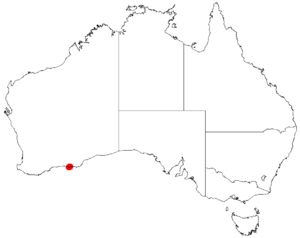Acacia incanicarpa facts for kids
Quick facts for kids Acacia incanicarpa |
|
|---|---|
| Conservation status | |
| Scientific classification | |
| Genus: |
Acacia
|
| Species: |
incanicarpa
|
 |
|
| Occurrence data from AVH | |
Acacia incanicarpa is a type of shrub. It belongs to the group of plants known as Acacia. This plant is special because it is found only in western Australia. When a plant or animal is found only in one specific place, it is called endemic.
About the Plant
What it Looks Like
This shrub usually grows to be about 1 to 2 meters (3 to 6 feet) tall. It often has a bushy, rounded, or cone-shaped appearance. Its branches are often ridged and can look a bit frosty or scaly.
Like many acacia plants, Acacia incanicarpa does not have true leaves. Instead, it has special leaf-like parts called phyllodes. These phyllodes are tough and have a silvery-grey-green color. They can be shaped like a spear, an oval, or an ellipse. Each phyllode is about 4 to 9 centimeters long and 7 to 14 millimeters wide. They have one or three main veins, with many thinner veins running parallel between them.
Flowers and Seeds
This plant blooms from November to December, or sometimes from January to April. It produces bright yellow flowers. The flowers grow in single, oval to short-cylinder shaped spikes. These spikes are about 7 to 10 millimeters long and 4 to 5 millimeters wide. They are packed with many light golden flowers.
After the flowers, tough, frosty seed pods grow. These pods stand upright or stick out. They are straight and linear, growing up to 10 centimeters long and 4 to 5 millimeters wide. Inside the pods are dark brown seeds that are somewhat shiny. The seeds are arranged lengthwise and are oblong-elliptic in shape, about 3 to 5 millimeters long. Each seed has a white cap at its tip called an aril.
Where it Grows
Acacia incanicarpa is found in a small area on the south coast of Western Australia. This area is part of the Goldfields-Esperance region. You can find it specifically within Cape Le Grand National Park, which is east of Esperance.
This shrub often grows on granite ridges and slopes. It prefers to grow in hollows where the soil is sandy and loamy. It is usually found as part of open scrub, heathland, or low shrubland plant communities.


